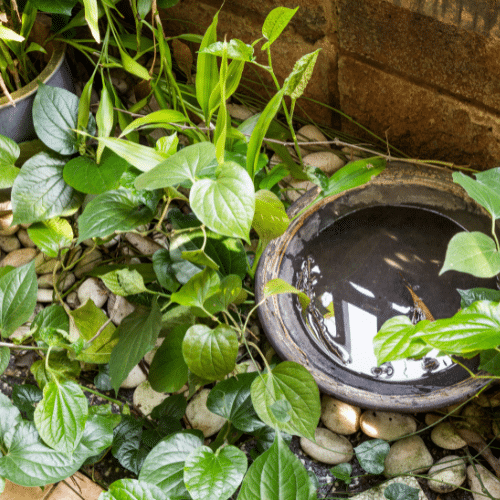
19 Feb Removing Standing Water
Ditch the Itch Mosquito Control 101!
Hey there, South Florida folks! Are you tired of those pesky mosquitoes buzzing around your home? You’re not alone! Mosquitoes are not just annoying; they can also carry diseases that pose serious health risks. But don’t worry, we’ve got you covered!
In this guide, we’ll dive into the world of mosquito control and show you how to keep your home mosquito-free. So, let’s get started and say goodbye to stagnant water and hello to a peaceful, bite-free environment!
First things first, let’s talk about the life cycle of mosquitoes. These little critters go through four stages: egg, larva, pupa, and adult. Understanding their life cycle is key to effective mosquito control because it helps us target them at different stages.
Mosquitoes love stagnant water. It’s where they lay their eggs and where their larvae and pupae develop. From old tires to bird baths and clogged gutters, any standing water around your home can become a mosquito breeding ground.
Clear Water, Clear Air
Now, let’s hunt for those stagnant water sources! Check your yard for any containers that might collect water, like flowerpots, buckets, or even toys. Don’t forget to clean your gutters regularly and keep your pool properly maintained.
Some water sources might not be so obvious. For example, check for leaks in your outdoor faucets or hoses that could create puddles. Also, be sure to fix any areas in your yard where water tends to pool after it rains.
Once you’ve identified stagnant water sources, it’s time to get rid of them! Empty and clean any containers holding water at least once a week. If you have a pond, consider adding a fountain or aerator to keep the water moving.
Additionally, if you have a birdbath, change the water every few days to prevent mosquito larvae from developing. For larger water features like ponds, introducing fish that eat mosquito larvae can be an effective way to control the mosquito population.
Yard Upkeep and Barriers
Regular maintenance is crucial for mosquito control. Make sure to fill in any low spots in your yard where water can collect. If you have a rain barrel, use a fine mesh to cover it and prevent mosquitoes from laying eggs.
Did you know that certain plants can help repel mosquitoes? Consider planting citronella, lavender, or marigolds around your outdoor living areas. Also, keep your grass and shrubs trimmed to reduce shady spots where mosquitoes like to rest.
Installing screens on windows and doors is a great way to keep mosquitoes out of your home. If you have a patio or deck, consider using mosquito netting to create a bug-free zone. Additionally, using outdoor fans on your patio can help keep mosquitoes away, as they are not strong flyers and struggle to navigate in the wind.
Chemical, Natural, and Protective Measures
If you need to resort to chemical control, make sure to use insecticides and larvicides safely. Always follow the instructions on the label and target areas where mosquitoes are most likely to breed.
For a more environmentally friendly approach, try using products containing natural ingredients like oil of lemon eucalyptus or neem oil. You can also introduce mosquito-eating fish like gambusia to your pond.
When you’re outdoors, use mosquito repellents that contain DEET, picaridin, or IR3535. Wearing long sleeves and pants can also help protect you from mosquito bites, especially during peak mosquito hours.
Additionally, consider using mosquito traps or zappers in your outdoor areas to further reduce the mosquito population and enhance your protection against these pesky insects.
Mosquito Timing: Avoiding Peak Hours
Mosquitoes are most active at dawn and dusk, so try to plan your outdoor activities outside of these times. If you do need to be outside when mosquitoes are buzzing, make sure to take extra precautions. Use insect repellent, wear protective clothing, and consider using portable mosquito nets or fans to keep them at bay.
Mosquito control is more effective when the whole community gets involved. Talk to your neighbors about eliminating stagnant water and share tips for keeping mosquitoes at bay. Organize neighborhood clean-up days to tackle common breeding sites, and encourage everyone to maintain their property to prevent water accumulation.
Many local governments offer resources and programs for mosquito control. Check with your city or county for information on community-wide efforts and how you can participate.
Some areas may have mosquito abatement districts that provide services like spraying and surveillance to reduce mosquito populations. By working together and utilizing available resources, we can create a safer and more comfortable environment for everyone.
Conclusion
In conclusion, the battle against mosquitoes can be won through diligent effort and proactive measures. By eliminating stagnant water sources and maintaining a tidy yard, breeding grounds for mosquitoes are significantly reduced. The use of screens, barriers, and mosquito-repelling plants further fortifies our homes against these unwelcome visitors.
Chemical and natural control methods, when used responsibly, can effectively reduce mosquito populations. Personal protection strategies, such as wearing repellent and appropriate clothing, provide an additional layer of defense. By being mindful of peak mosquito activity times and taking extra precautions, we can enjoy our outdoor spaces with greater peace of mind.
Lastly, the power of community action cannot be overstated. By collaborating with neighbors and participating in local government programs, we can amplify our efforts and achieve a more comprehensive mosquito control. Together, we can create a safer, more enjoyable environment for all South Florida residents.


No Comments